By C. Todd Lopez
FORT POLK, La. (Nov. 14, 2012) -- Last month, about 1,200 Soldiers parachuted into the Joint Readiness Training Center here to participate in a "Decisive Action Training Environment" exercise meant to prepare them for the hybrid threats the Army will likely face as it shifts away from engagement in Afghanistan.
The Joint Readiness Training Center, or JRTC, has for years conducted "mission readiness exercises," or MREs, specifically tailored to ready Soldiers for deployment to Iraq and Afghanistan. Those exercises focused primarily on training units for counter-insurgency operations that were already manned by American forces stationed in established forward operating bases. When Soldiers arrive in those locations now, they replace units already established there through a "relief-in-place transfer of authority."
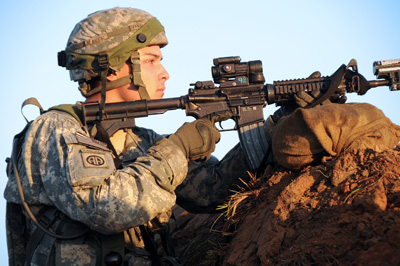
DAY ONE IN THEATER
The Decisive Action Training Environment, or DATE, exercise goes well beyond what the MREs offered. The DATE training prepares Soldiers for day-one of a military operation, before the hard facilities have been built, the exchange service sets up shops, the fitness centers are installed, and contractors come on board to put in wireless internet in the tent cities. They also exercise a brigade's mission-essential task list, and support the Army's core competencies, including both wide-area security and combined arms maneuver.
JRTC has held "full-spectrum operations" training in the past, the last one was just two years ago, and before that it had been about seven or eight years. But now, after more than 10 years of conflict, "full-spectrum" has been modified into "decisive action" by incorporating lessons learned from conducting Counter Insurgency, or COIN, operations in Iraq and Afghanistan, and reflecting the more complex threat environment.
Within the JRTC rotation 13-01 DATE scenario, which ran Oct. 9-21, the hostile nation of "Arianna" invaded U.S.-friendly "Atropia" for its oil, and attacked the U.S. consulate in the Atropian city of Dara Lam. American forces intervened.
GLOBAL RESPONSE FORCE
Soldiers from the 2nd Brigade Combat Team, 82nd Airborne Division, about 4,800 Soldiers in all, exercised their role as a global response force by deploying to Atropia to assist. About 1,200 of those did so immediately with a "forcible entry" into Atropia, when they parachuted into a completely bare JRTC training range to help expand the foothold of "friendly forces" already in the area.
After establishing a lodgement area and securing an airstrip that allowed additional American forces, equipment and supplies to be brought in by aircraft, Soldiers from the 2/82nd, with assistance from Army Special Operations Forces, conducted a noncombatant evacuation operation, or NEO, to get Americans out of Dara Lam. Soldiers from the 2/82nd stayed behind to secure the city as well.
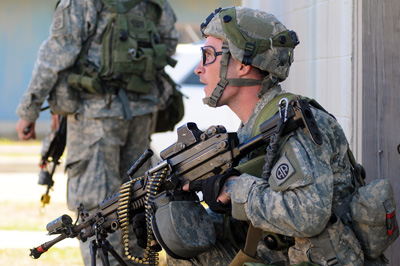
In addition to the forcible entry and NEO portions of the DATE scenario, Soldiers were also required to conduct both a defensive and offensive operation against a "hybrid threat" of guerrilla forces, insurgents, criminal elements, and "near-peer" conventional forces from hostile states.
DATE FREE-PLAY
When a unit has in the past come to JRTC to participate in an MRE in advance of an Afghanistan deployment, they already knew what region of the country they were going to deploy to and what type of enemy they could expect to be up against.
With that knowledge in advance, JRTC has been able to develop training scripts tailored to what the unit will see in theater, said Capt. Dennis Grinde, the rotational planner for the 13-01 rotation.
In such a script, training designers plan multiple "injects" into the scenario to better guide training for the unit and to ensure the unit will see the kinds of things in training that it's expected they will see in theater. With an MRE for Afghanistan, Grinde said, there are about 400-500 injects into the scenario.
But DATE scenarios have to prepare Soldiers for unknown environments and unknown threats. In order to better approximate the unknown, there are less than 40 injects into the last DATE training event, Grinde said.
Units tasked as a global response force, such at the 2/82nd, might know what part of the world they will go to. What they don't know is what country they will be asked to go to, or what region, or what enemy they will face. They have to be prepared to go just about anywhere.
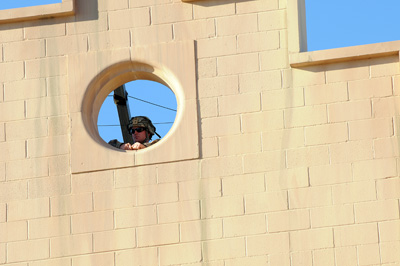
"We're really trying to train the unit here that is not necessarily defined in a particular environment," Grinde said. "It's a free-thinking, aggressive enemy that has realistic capabilities, and realistic motives. There's an increased amount of free-play, an increased amount of thinking out there."
NEAR-PEER COMPETITORS
Brig. Gen. Clarence K. K. Chinn, the commander of both Fort Polk and the JRTC, said that during a DATE training scenario, "anything is possible." That, he said, is something a unit like the 2/82nd must be prepared for.
As the nation's global response force, Chinn said the 82nd must be able to respond within 96 hours to a notification to be anywhere in the world, where they could face just about any kind of threat. The DATE scenario at JRTC has been developed to ready them for that situation.
"We've got to be prepared to fight in an environment where we may face a near-peer competitor," he said. "We can't be allowed to be surprised. In Afghanistan, we've fought a COIN fight. That's not the fight we think we may be in, in the future. For every unit here, we have to make their toughest day here."
THE HYBRID THREAT
To make DATE training realistic, JRTC has developed a formidable set of adversaries for units that will train. The DATE trains Soldiers against a "hybrid threat" that includes guerrillas, insurgents, criminal elements, bandits, gangs, and conventional forces from hostile states that are rated as "near-peers" to American forces. That means they have the same kind of equipment and know many of the same kinds of tactics that Americans know.
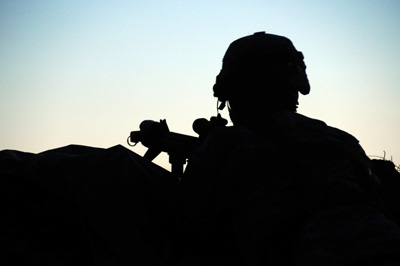
Grinde said the near-peer forces possess GPS jamming capability, armored personnel carriers, modified tanks, attack helicopters, artillery, and nuclear, biological and chemical capability. He also said there is a developing cyber threat that will allow the "OPFOR," or opposing forces, to get into the brigade's computer systems.
"It's in its infancy now, but it's a threat the 2-82 will have to watch out for," he said.
HERE TO LEARN
"In my 25 years of service, this is the best training I have ever conducted; it's that good," said Lt. Col. Kevin Quarles, deputy commander of the 2/82nd. "The team here at JRTC has exceeded our expectations, caused us to get out of our comfort zone, think creatively, and be adaptive."
Quarles said the core mission of 2/82nd is to conduct forcible-entry operations, like the one at the onset of rotation 13-01, and that the training scenario presented to his brigade at JRTC is exactly what the unit needs to prepare itself to deploy as a global response force.
More importantly, Quarles said, is what being learned at JRTC as part of the DATE training that is going to help fill in the experience gaps in his brigade that have been left by 10 years of conducting predominantly COIN missions in Iraq and Afghanistan.
"As we surveyed our formation and talked to our leaders and asked them when the last time they conducted a defense was, we found we have about a decade-gap that corresponds to the amount of time that we have been committed to the conflicts [in Afghanistan and Iraq]," Quarles said.
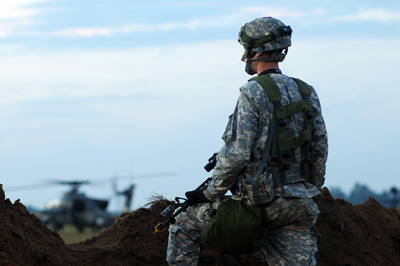
"In an environment like this, in an expeditionary environment, we've got to read our doctrine, we've got to go back to our field craft, and we've got to ensure that the leadership and the paratroopers are ready for the hardships ... and that is exciting," he said.
'WHAT'S ON YOUR BACK'
When Soldiers parachuted into the JRTC training range at Fort Polk, La., there was nothing there except dirt, wild horses and port-a-potties -- regulations don't allow the Soldiers to dig latrines on the training range there.
"If you didn't bring it with you on your back, it is not there," said Command Sgt. Maj. Jason Mosher, 2/82nd Brigade Special Troops Battalion. "That is very different from how the Army is used to doing things, where you could go in, open your computer, find something, order it, and it shows up in 48 hours. The AAFES tent will not come here."
Mosher said one of the biggest challenges for his Soldiers was learning to live in austere conditions that were always vulnerable to enemy forces.
"They have a hard time wrapping their head around sleeping on the ground in all-weather conditions," Mosher said. "Some people have a hard time wrapping their head around conducting 24-hour operations in an environment that is hostile and not having a location to go to in order to decompress, one that is completely shielded from those hostilities. That is the difference between an expeditionary force and one that does what we call RIPTOA, or relief-in-place transfer of authority. That's what the force of the last decade has been accustomed to."
Mosher has been involved with expeditionary forces before -- he's been in the Army for more than 23 years now. But like Quarles, he said there's a shortage of Soldiers with real experience in expeditionary operations. Many in his unit, he said, entered service in the last decade.
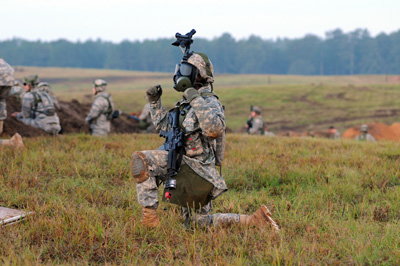
"If you look at the progression of the enlisted force and the officer corps, there is a strong likelihood that a Soldier witnessed 9/11 as a civilian, in high school or in college," he said. "They dropped everything they were doing and enlisted in the U.S military in a time of war."
Now, he said, those Soldiers have attained senior rank, but without the experience of the expeditionary Army.
"They are now senior leaders," he said. "For those who are not first sergeant or above or lieutenant colonel or above, there is a strong possibility they haven't seen this. So there is a large learning curve here. And the more senior of us are doing everything we can to ensure the next generation of Soldier is prepared."
ON THE GROUND
After Soldiers parachuted into JRTC, they were responsible for defending the area they dropped into, expanding the lodgment area, evacuating American citizens from the training city, and then defending the city from a very skilled OPFOR.
Spc. Jacob Gallagher, a team leader with A Co., 1/325th, 82nd Airborne Division, was one of those charged with defending the fictional city of Dara Lam.
"We had some American citizens we had to help escort out of here and get them to safety areas and get them out of danger," Gallagher said. "And right now we've had some defensive attacks from SAPA, the local army of Dara Lam and the Atropia area."
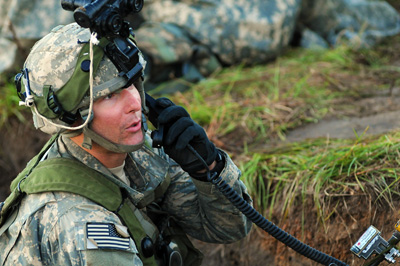
Gallagher stood in the "city" of Dara Lam -- built at JRTC as a Soldier training aid -- across from the American consulate, with a rifle across his chest. He'd been on the ground for more than week. He said he was on his second pair of ACU pants because the first had worn out; so had the second.
The day before, he said, the "South Atropian People's Army" which served as the insurgent force inside Atropia, had entered the city in tanks. He'd been inside one of the buildings there, which were equipped with machine gun bunkers, when the enemy rolled into town.
FORCE ON FORCE
"It wasn't until about 9 a.m. when we got our first hits, and the first engagements started," he said. "Then all the tanks started rolling through. It was kind of a tank battle out there with our Delta trucks and our gun trucks and our 50-cal. verses the tanks and their machine guns. It was pretty crazy."
American forces took losses, he said, "but a lot less than the enemy." He also said he got "hit in the ribs" -- which in a training scenario might register as a hit on the laser tag-like MILES gear -- and was put through some medical care before a tactical pause in the exercise was called and he was eventually put back in the exercise.
This is Gallagher's second rotation though JRTC. The first time, he said, was different because it was just company-level training. But the DATE training is much bigger.
"You kind of see the whole Army working as one," he said. "You see the whole machine. As far as me being a team leader, and having my Joes pulling security as far up as brigade commanders, company commanders, battalion commanders, and seeing what they are doing and having other support units from different divisions-- it's a bigger picture."
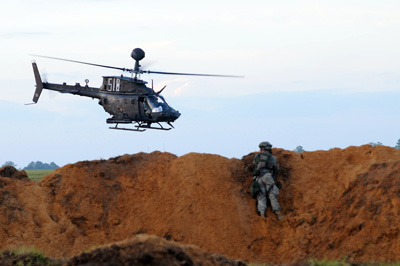
Gallagher said he doesn't just see the JRTC rotation as being good for him. He said he sees benefit for nearly everybody who's involved.
"This is good for me, it's good for everybody," he said. "From my team to other teams, the gun teams, Joe on up to platoon leader. We just got a new platoon leader, and this is his first cycle, so this is good training for him. It's a different type of atmosphere, a different type of environment. You never know what you're going to face when you go overseas."
ADAPTING ARMY
Sgt. Ronald Brown Jr., an operations sergeant with A Co. 2/82nd Brigade Special Troops Battalion, didn't parachute into the JRTC rotation, but arrived two days after "P-hour" to take accountability of fuel and equipment.
But Brown has been in the Army for a while now. He did a four-year enlistment starting in 1993, well before 9/11 happened. The Army then was all about full-spectrum operations -- it wouldn't start its 11-year focus on COIN for another eight years. But Brown got back in the Army in 2005, and has served since then. He said the Army he came into the second time was different than the one he knew as a younger man.
"It was definitely a different Army as far as the training aspect goes, going from what I call old school to the COIN operating environment -- insurgent- and terrorist-based, more non-conventional type of warfare," he said. "But I learn fast and adapt fairly quickly."
Some of what he knew from the Army back in 1993 is what is being retaught to Soldiers today -- along with all the lessons learned from Iraq and Afghanistan. He's talked to his Soldiers about what he knows from his first time around.
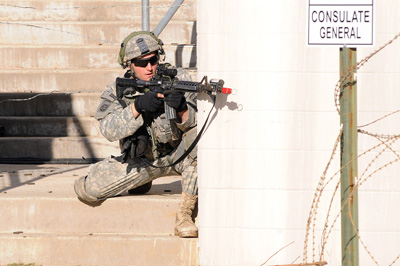
"This is more of an eye-opener for them," he said. "I've already talked to my Soldiers within my element, letting them know direct action means force-on-force, and we are fighting near-peer assets as opposed to an insurgent or terrorist type action," he said, adding that he thinks the more robust training will help develop both him and his Soldiers into better warriors.
"It's going to blossom us, and open our eyes to what can come in the future, what to expect, and how we can better ourselves as a unit," he said.
TRAINING FOR THE WIN
There were two "hard stops" during the DATE exercise -- one after the NEO, and one after the defense portion of the exercise was complete. There was also an after-action review at the conclusion of the training. During those times, Soldiers, commanders and exercise observer-coach-trainers discussed the unit's performance in each phase of the training.
Even while the training was ongoing, OCT personnel remained among the rotational training unit to guide and coach them as they performed their tasks under stress, and attempted to achieve their objectives.
"We always have an officer and an NCO out there providing immediate feedback to them and coaching, observing and teaching them all the way; so it's constant feedback, all the time," Chinn said.
The feedback, the coaching and the evaluations are meant, Chinn said, to help Soldiers see what they've done wrong while training, so they don't do it again.
"That's the whole key to training, to make sure that if we make mistakes, we make it here, we figure it out and make it work, so it's not a problem on the battlefield, and we don't have to pay in red with our blood," Chinn said.
At the end of a DATE training rotation at JRTC, it may be hard to determine who was the winner of the fictional scenario, was it the rotational training unit or the OPFOR? Did the Americans defeat Arianna forces? Did they subdue the insurgency by the South Atropian People's Army, or were they overrun?
Chinn said the outcome of the scenario is not important, it's the learning that is important. Soldiers come to JRTC to make mistakes so they don't make them in combat.
"When you come to JRTC or go to [the National Training Center at Fort Irwin, Calif.], we all want to win, but you've got to understand that you're coming here to learn and grow, do after-action reviews and modify your behavior," said Chinn. "Sometimes the BCT actually wins by defeating OPFOR, but in the end what we are looking for is better trained Soldiers and leaders."